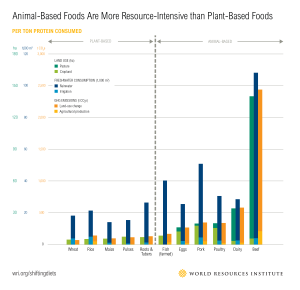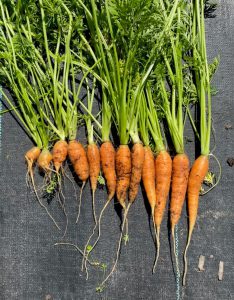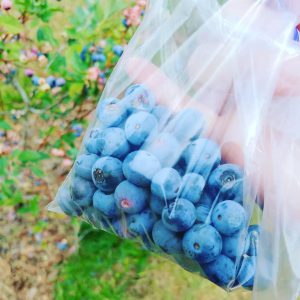
by Suzanne Holloway | Apr 28, 2025
Dietary protein is an important macronutrient for human health, and it can be found in a wide variety of foods. To learn more about the basics of protein, check out this earlier article.
Types of Protein Sources
Before we explore the different types of protein food sources, it is important to think about what else comes with it. When you eat foods that are rich in protein, you are also getting other things like fats, fiber, sodium, and other nutrients. Current evidence suggests that the “protein package,” has a greater impact on our health than the amount of protein eaten.
Traditional Animal-based

Source: World Resource Institute (Click on the image to see a larger version.)
Traditional sources like beef, pork, lamb, poultry, and seafood usually come from farms or wild sources. These proteins are complete protein sources because they contain all nine essential amino acids: histidine, isoleucine, leucine, lysine, methionine, phenylalanine, threonine, tryptophan, and valine. Additionally, animal-based protein is referred to as “high-quality” protein due to its high concentration of amino acids and digestibility, rather than its impact on human health or the environment. Regardless, it is important to note that not all animal-based proteins are created the same.
Red and Processed Meats
Red meats like beef, pork, and lamb, and processed meats, such as luncheon meats, hot dogs, and jerky, are high in saturated fats; furthermore, processed meats also contain a high amount of sodium. High intake of red meat, especially processed meats, has been linked to increased risk of cardiometabolic diseases, like heart disease, stroke and type 2 diabetes, and various cancers.
Dairy
Dairy products like milk, cheese, and yogurt are good sources of calcium, protein, and other important nutrients. But they can also have a lot of saturated fat, so it is better to consider the low-fat options.
Poultry and Eggs
Poultry, like chicken and turkey, is defined as a “high quality” and complete protein source like red meat. However, poultry, unlike red meat, generally has a lower saturated fat content; a notable exception to this generalization is duck. Eggs are also a complete source of protein with healthy fats and other nutrients.
Seafood
Seafood, such as salmon, Pacific oysters, tuna, and whitefish contain important types of omega-3 fatty acids, like eicosapentaenoic acid (EPA) and docosahexaenoic acid (DHA). Omega-3 fatty acids are a type of polyunsaturated or “healthy” fat; they play an important role in cellular membrane function and support the function of the cardiovascular and endocrine systems. The major concern involved in consuming seafood, specifically fish, is the amount of mercury present; however, these levels vary between species. For advice on eating fish, check out this article from the FDA.
Plant-based
Beans, Peas, Lentils, Grains, and Soy
Beans, peas, and lentils are great plant-based proteins that also give you fiber, vitamins, and minerals. However, typically, a single type of bean, pea, or lentil does not constitute a complete protein by itself. It is advised to mix different types or add other foods to get complete protein, like the classic combination of rice and beans. Soybeans and soy products, like tofu and tempeh, are also a good source of protein, especially for those on a vegan and vegetarian diet. Rice is also a good source of protein, but like other plant-based sources, does not provide a complete protein and should be combined with other foods to ensure adequate intake.
Nuts and Seeds
Nuts and seeds like almonds, peanuts, chai seeds, and sunflower seeds, are a good source of protein and healthy fats. However, due to their high fat and calorie content be mindful of your portion sizes. Quinoa, which is often classified as a pseudo-cereal but is a seed, is a complete protein.
Microbe-based
Microbial protein comes from microorganisms, mainly fungi (such as yeasts and filamentous fungi), microalgae (like cyanobacteria), and bacteria. The utilization of microbes for protein and food processing is not a new idea and can be observed in the making of bread, yogurt, and cheese, as well as in the direct consumption of yeast and algae. Two of the most well-known types of microbe-based proteins are nutritional yeast and spirulina. Some of the limitations of microbe-based proteins are the cost and product quality. They are not considered a complete protein because microbial protein only has eight out of the nine essential amino acids.
Insect-based
The practice of consuming insects, such as grasshoppers, ants, bees, and caterpillars, has long been established in several cultures throughout South and Central America, Africa, Asia, Oceania, and Europe. Insect-based protein is similar in quality to that from livestock but is more resource-efficient. However, it is important to consider species-specific health concerns, such as potential microbial, allergenic, and toxicological risks.
Cultivated Animal-based
Cultivated or lab-grown meat is an innovative technology that could transform the traditional meat industry. This process involves extracting cells from an animal, without slaughter, and then the cells are grown, harvested, and processed into meat for human consumption. The first lab-grown meat, a beef burger patty that cost $330,000, was developed by a scientist in the Netherlands in 2013. Since then, technological advancements have expanded product offerings to include cell-cultivated versions of pork, chicken, and seafood. The significant challenges facing the cultivated meat industry include scaling up production, reducing the costs of finished products, and replicating the taste and texture of conventional animal products. Still, since it comes from animal cells, it is a complete protein source.
Conclusion
Each protein source comes with its unique set of nutrients, which collectively impact our health more than the protein content alone. Understanding the complexities of each protein source—from traditional animal-based proteins to innovative lab-grown meats—helps us make informed dietary choices that align with our needs and considerations.
Additional Sources
Harvard Health
American Heart Association
World Resources Institute
The Nutrition Source
An Equal Opportunity Institution.

by Heidi Copeland | Apr 7, 2021

Carrots
Photo source: Heidi Copeland
According to industry standards, some of these carrots could not be sold because of “Serious damage” or any defect which seriously affects the general appearance of the
carrots in the container.
Waste less, save money is a great creed to live by. Really, it is that simple. One excellent example of this is food. Research indicates that 40% of all food in America is wasted yet, one in eight Americans does not have enough access to affordable, nutritious food. In other words, they are “food insecure.”
Wasted food is a MASSIVE problem at the commercial, institutional and residential levels. In fact, the Environmental Protection Agency (EPA) estimates there is more food than any other single material in our everyday trash and that approximately one-third of all food produced for human consumption worldwide is lost or wasted. In fact, in 2015, the USDA joined with the U.S. Environmental Protection Agency to set a goal to cut our nation’s food waste by 50 percent by the year 2030.
The sad fact is, most people do not realize how much impact food and food waste has on the earth and its issues of sustainability. Food waste occurs at every level of involvement. Examples of food waste include growing, processing (by-products too), transporting, point of sale, plate waste and uneaten prepared foods, and kitchen trimmings and their eventual disposal. Preventing food waste at all these levels can make a difference in addressing this issue.
However, preventing food waste it is not as easy as it seems. Many consumer factors also contribute to the problem.
- Food date labels confuse people. Use by/sell by dates are not always about food safety but about peak quality. Many foods are still safe to eat after their dates. Inspect “expired” foods closely via sight and smell before consuming – find ways to use up food past its prime.
- Households overbuy – do you really need super sizes? Buying in bulk is not always less expensive if much of it is discarded. Only purchase what you know you will use and do not get lured in by the “more for less” deals.
- Massive portions are often served – share or learn to love leftovers. Split enormous portions into multiple meals.
- Grocery stores overstock their shelves to maintain an image of abundance.
- People demand “perfect” produce. Farmers have a hard time selling less than stellar items. “Ugly” fruits and vegetables are just as delicious and nutritious as their more photogenic counterparts. Places such as farmers’ markets and community gardens are good places to find imperfect produce that would otherwise go to waste.
This Earth Day, (an event first celebrated on April 22, 1970 in the United States and is now a globally coordinated event in more than 193 countries) commit yourself to taking an action. As the late Neil Armstrong famously quoted as he stepped on to the moon… “This is one small step for a man, one giant leap for mankind!” If each of us considered and implemented our own practical or creative approaches to preventing food from going to waste what would our collective actions mean for mankind?

Fresh Carrots
Photo Source: Heidi Copeland
The best way to reduce food loss at home is not to create it in the first place. Not only would we individually save money, our collective efforts could conserve resources for future generations. The best method is the one you use.
- Reduce wasted food – shop smart, plan what you purchase, and use it, ALL of it!
- Maximize the efficiency of your refrigerator based on science. Read your refrigerator manual to learn where the coldest spots in the refrigerator are and what foods benefit from refrigerator location.
- Maximize the efficacy of canned products… use the FIFO (first in first out) method of rotation to use the oldest product before the newest on the shelf.
- Donate what you cannot use to others.
- Divert food scraps to animal food (chickens anyone?)
- Compost
- Landfill as the last resort.
Common causes of personal food waste include overbuying, over preparing and spoilage. The basic tenets of sustainability – reduce, reuse, recycle and refuse, work to reduce food waste too! Pay attention to purchases, eat what is prepared, store food properly, and refuse to waste. We can all do our part! Let’s start today.
https://savethefood.com/recipes/

by Heidi Copeland | Mar 25, 2020
It’s hard to believe, but Wednesday, April 22, 2020 marks Earth Day’s 50th anniversary. As far as anniversaries are concerned, the 50th is definitely a milestone, often commemorated with something lasting and treasured.
Kind of ironic then that this year’s Earth Day theme is “Climate Change.” According to the Earth Day Network, this theme represents the biggest challenge to the future of humanity and the life-support systems that make our world habitable.

All these tiny pieces of plastic started out as bigger pieces of plastic, which broke down over time and ended up in our waterways. (Photo source: Tyler Jones, UF/IFAS)
This year’s theme harkens back to 1970, when the first Earth Day was celebrated with an objective to spread awareness. Twenty million Americans (10% of the country’s population at the time) protested environmental ignorance and demanded protections for our planet. These demands eventually led to the passage of landmark environmental laws in the United States, including the Clean Air, Clean Water, and Endangered Species Acts. Many countries soon adopted similar laws.
As Extension agents, we are tasked with providing research-based, reasonable, and helpful information on a variety of topics that can improve people’s lives. Climate change is a divisive issue. In fact, a University of Florida IFAS Extension EDIS fact sheet called “Challenges in Communicating Climate Change to Extension Audiences” outlines the many challenges of discussing climate change with typical audiences.
| Six Americas Audience Categories |
Description |
You might hear |
| Alarmed |
Convinced global warming is a serious and urgent threat; highly engaged; most likely to change behavior |
I’m so upset and worried about the future. |
| Concerned |
Convinced global warming is a serious threat; somewhat engaged; less likely to change behavior |
I think this is something politicians should address |
| Cautious |
Believe global warming is a problem but not a personal or urgent threat |
So what is it all about? |
| Disengaged |
Give little thought to global warming; change beliefs easily; not perceived as a problem for them |
I have other things to think about, like how to pay the bills. |
| Doubtful |
Not sure if global warming is happening |
Seems like climate always changes. This is a political issue. |
| Dismissive |
Firmly believe global warming is not occurring; highly engaged in preventing change in policies; very knowledgeable |
It is arrogant to believe that people can change the climate. This graph shows the scientists have it wrong. |
Nonetheless, Extension agents are well-informed and desperately care for the health and welfare of their families, neighbors, and communities. Especially now, as collectively, we all are facing an uncertain future.
The coronavirus pandemic has stressed our lives right now. Everyone is grappling with change. Everyone is worried about human health. Even with everything else going on, Earth Day is a yearly reminder to exercise our collective responsibility. As one human race, we just can’t sit back and relax and hope everything turns out okay. It is going to take some work.
So instead of feeling like our time is being wasted by staying at home, perhaps we can spend this time in a positive way. I heard a news commentator recently say something along the lines of not letting this time we all have now to use us, but for us to use this time to come out better on the other end.
Like Helen Keller famously said, “Alone we can do so little; together we can do so much.” Let’s start together.
Here are some tips and resources for saving energy, money, and the environment:
Save Energy, Save Money (https://www.energy.gov/energysaver/energy-saver)
-
- Install a programmable thermometer
- Hang clothes to dry when you can
- Look for energy star appliances when shopping for a replacement
- Change to energy efficient light bulbs
Understand personal water consumption (https://www.epa.gov/watersense/how-we-use-water#Daily%20Life)
Say NO to plastic (https://www.epa.gov/trash-free-waters/toxicological-threats-plastic)
-
- Carry your own reusable bag
Eat with a conscience (http://www.floridaclimateinstitute-uf.org/)
-
- Eat more meatless meals
- Don’t waste food
- Cook more
Think about personal consumption (https://moneytalk1.blogspot.com/2020/03/when-things-seem-out-of-control-control.html)
-
- Consume less
- Waste less
- Enjoy yourself more
Support your leading environmental movements. Youth around the globe are passionate about this. They worry, and rightly so, about what is going to happen, now and in the future.

by Angela Hinkle | Sep 3, 2019
Hurricane season is June 1 to November 30, with peak season in September and October. And hurricanes are not the only disasters we have to contend with. Living Well in the Panhandle provides the trusted Disaster Resources you need so you know what to do to keep your family and you living well.
Disaster Resources
Below are helpful resources for preparing for and handling the aftermath of a disaster. For more information, please contact your local UF/IFAS Extension Office.
Food Safety
Is My Food Safe to Eat?
Keeping Your Food Safe During Emergencies: Power Outages, Floods, and Fires
USDA – A Consumer’s Guide to Food Safety-Severe Storms and Hurricanes Guide
Well Water Safety
Well Water Testing
Housing
Search for an open emergency shelter near you by texting SHELTER and your zip code to 4FEMA (43362) Example: SHELTER 01234

Lightning storm. Photo Source: UF/IFAS
Cleaning Up After a Hurricane
Safety Comes First!
Get the Right Tree Care Professional
Hiring an Arborist – Spanish
Cleaning Mold After a Flood
Hurricanes and Mosquitoes
Mosquito Control Tips for Homeowners
Money Management/Consumer Issues
Avoiding Fraud and Deception
Six Steps in Making an Insurance Claim
Replacing Lost or Damaged Documents
FEMA – Individual Disaster Assistance
FEMA – Interim Housing Resources
USDA Farm Service Agency Disaster Assistance
Disaster Recovery Loans
Tax Relief After a Disaster
Complaints – If you have a complaint about disaster relief assistance, contact the Department of Homeland Security’s Inspector General’s Office at 1-800-323-8603.
Family Health and Wellness
Call the Disaster Distress Helpline 24/7 for free counseling – 1-800-985-5990 (TTY) 1-800-846-8517
OR text TalkWithUs to 66746
Mental Health for Adults
Mental Health for Kids
Mental Health for Adolescents
Agriculture and Natural Resources
Practices to Minimize Flooding Damage to Commercial Vegetable Production
Florida Panhandle Agriculture
Florida Panhandle Agriculture Facebook

by Stephanie Herzog | Aug 24, 2019
September is National Preparedness Month, so right now is a great time to think about how you can be prepared, and then act on those thoughts and get ready for an emergency! This article will help get you thinking, give you some great starting points, and provide resources to turn to.
Emergencies Have a Wide Horizon
While hurricanes are likely the first thing panhandle residents think of when it comes to emergencies, are you prepared for others? Fires? Floods? Hail? Lightning? Tsunamis? Drought? Heat waves? Tornadoes? Possible winter storms? Marine oil spills? Major sewage problems? Other life-threatening medical disasters? Being prepared for a hurricane like Michael is vital to panhandle life, but it’s certainly wise to consider other possible disasters and to be prepared for anything.

Being prepared for an emergency can greatly reduce the stress it causes. (Photo source: Stephanie Herzog)
There are also so many ways to prepare for emergencies that it can be overwhelming to think about. Do you have sufficient food storage? What about clean water for your whole family (pets included)? How are you going to wash your clothes? How do you purify water? What if your toilet isn’t usable, what do you do? Can you safely start a fire if there’s no heat? What about shelter? How do you stop a gaping wound? How do you turn off the water to your house? What is the best evacuation route? How do you contact someone when there’s no power? Are those potentially life-saving prescriptions easily accessible? Where is the deed to your house, the title to your car, and your family’s vital identification documents? You’re filing an insurance claim, and you have no idea what brand your Smart TV was, where you bought it, how old it was, or how much it cost – what do you do?
Preparation Brings Relief
Have all of these questions got you thinking, but perhaps exhausted you? Now imagine that you could answer every one of these questions confidently – how do you feel? A weight lifted? Stress is a central source of fatigue for us all, and with it comes a variety of problems – mental, physical, financial, and social. Think of a time when you were prepared for the expected or unexpected – was your stress considerably less? Most likely it was. Preparation is a positive, proactive behavior that gives foresight into the unknown. Procrastination tends to be the default within a human’s nature, so being prepared doesn’t necessarily sound like a fun thing to do with your time. But it will be a game-changer for your life when the time comes that you have to react swiftly and decisively in the event of an emergency. The investment is well worth it!
However, you don’t have to do it alone. Thankfully, there are many professionals here to help you! Here are a few starter tips to aid you in the beginning of your preparation:
- Human Life. First and foremost, in an emergency the highest priority is that of preserving human life. Material objects can be replaced – a life cannot be. Always keep this in mind while preparing for and responding to emergencies!
- Sustenance Storage. Have adequate food and water storage for your needs. Label your food and water storage with the month and year to help track expiration dates.
- Canned and dehydrated foods are great for storage, and many items have a long shelf life.
- Remember one gallon of water per person/pet per day – store as much fresh water as you can! You can only survive a few days without water, but weeks without food.
- Plan in your near future to eat and drink the food and water supply that are nearing expiration and then replace the storage with fresh sustenance.
- 72-Hour Kit. Have a 72-hour kit for each member of your family, including pets. Backpacks or duffel bags are ideal grab-and-go containers. Keep a 72-hour kit both in your home and in your car.
- Review Annually. Pick one Saturday a year as your “emergency preparedness day” where you review all of your food and water storage, medical supplies and prescriptions, fire extinguishers, and all other emergency materials.
- Make an inventory and then head to the store to replace any expired or missing items.
- Clean and organize your storage space and emergency kits so everything is accessible.
- Evacuation Plan. Have an evacuation plan and put it on the calendar to practice it with your family – and even neighbors – every three months.
Start now to be prepared!
Additional Resources
Sources
Jaffe, E. (2013, March.) Why wait? The science behind procrastination. Association for Psychological Science. https://www.psychologicalscience.org/observer/why-wait-the-science-behind-procrastination
Steel, P. (2007). The nature of procrastination: A meta-analytic and theoretical review of quintessential self-regulatory failure. Psychological Bulletin, 133(1), 65-94. http://dx.doi.org/10.1037/0033-2909.133.1.65

by Stephanie Herzog | Jul 25, 2019

Eating fresh, local produce is a great way to be healthier, save money, and support the local economy. (Photo source: Stephanie Herzog)
Summer Local Eats – Supporting Farmers’ Markets
Summer is a great time of year to eat locally grown fresh produce! There are many options rich in a variety of colors, shapes, sizes, and nutrients. Farmers work hard to provide life-sustaining sustenance for society, and consumers supporting their efforts at the local level has an array of health and economic benefits.
Fresh summer crops in the panhandle abound. Produce that is ready this time of year includes peppers, cucumber, peanuts, okra, squash, corn, and watermelon. Spice up a summer salad with fresh cucumbers or peppers or try tasty yellow meat watermelon for a chill and nutritious summertime snack! Local, fresh produce is a healthy alternative to processed foods or produce found in grocery stores. Produce sold by local farmers is freshly picked and because you know where it comes from, it is both safer to eat and keeps for longer periods of time than grocery store produce, which often has traveled long distances, is seldom inspected, and is kept in storage before finally being put out on the floor for purchase.
Supporting your farmers’ market benefits both you and your community in many ways. Purchasing from local farmers and farmers’ markets is both financially sound for you and is supportive of the community’s economy – the money changes hands locally and creates and maintains jobs. Not only does it benefit the economy, it also fosters a stronger sense of community unity and trusted relationships, which is vital to any successful society and local economy. For example, farmers will sometimes offer a “u-pick” program, depending on the crop, where you go to their farm and pick what produce you want right from the field! You get to keep half, and the farmer keeps half. This is a great cooperative effort that benefits everyone – you get free, fresh produce, and the farmer gets free labor. Who doesn’t love a win-win scenario?
Jackson County farmers’ markets information. Residents in Jackson County have a wonderful farmers’ market in the heart of downtown Marianna, located at Madison Street Park (2881 Madison St.) that goes throughout the summer every Tuesday, Thursday, and Saturday morning from 7am-12pm. After September, the market will continue through the fall, winter, and spring each Saturday at the same time. Tuesday and Thursday have farmer vendors only, while Saturday includes a variety of vendors, such as arts and crafts, plants and flowers, jams, jellies, honey, etc. This market also offers a raffle when you purchase items from vendors! For any questions about the market or how to join as a vendor, visit their Facebook page or contact Tony Mayo, the current farmers’ market manager or Terry Johnson, the public relations manager for the market. His number is 850-592-5114. It’s a good idea to bring cash or checks, but some vendors do accept credit and debit cards.
Want to find a farmers’ market near you or learn more about the benefits and best practices shopping at a farmers’ market?
Come experience the buzz and benefits of the farmers’ market!
Sources:
Local farmers at the Marianna City Farmers’ Market
Wang, Q., Evans, E. A., Pikarsky, M., & Olczyk, T. Consuming local vegetables from our local growers. UF IFAS publication HS1251.













